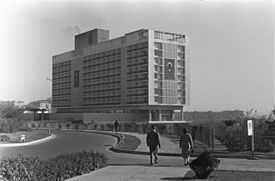Hilton Istanbul
| Hilton Istanbul | |
|---|---|
 Hilton Istanbul seen from north (2011) | |
 Location of Istanbul Hilton Hotel within Istanbul.
| |
| General information | |
| Location | Cumhuriyet Cad., Elmadağ, Şişli |
| Town or city | Istanbul |
| Country | Turkey |
| Coordinates | 41°02′40″N 28°59′20″E / 41.04444°N 28.98889°ECoordinates: 41°02′40″N 28°59′20″E / 41.04444°N 28.98889°E |
| Opening | June 10, 1955 |
| Owner | Emekli Sandığı (Pension Fund) |
| Management | Hilton Hotels |
| Technical details | |
| Floor count | 11 |
| Design and construction | |
| Architect | Skidmore, Owings and Merrill (SOM), USA |
| Other information | |
| Number of rooms | 499 |
| Number of suites | 13 |
| Number of restaurants | 6 |
| Website | |
| www.hilton.com.tr/tr/hilton-istanbul/ | |
The Hilton Istanbul (Turkish: Hilton İstanbul) is a five star hotel in Istanbul, Turkey. It is located at Cumhuriyet Cad. in Elmadağ, Şişli, in walking distance from Taksim Square. Opened in 1955, it is a branch of the Hilton Hotels chain.
It was Turkey's first modern hotel built from the ground up in the aftermath of World War II in Europe. Currently, it is also titled with Hilton Hotels' longest-serving member outside the United States.[1]
Project

On December 19, 1950, Conrad N. Hilton revealed to the New York Times that he had recently reached an agreement with the Turkish Government to build a new Hilton hotel in Istanbul with 300 rooms costing US$5 million. The U.S. governmental agency Economic Cooperation Administration (ECA), which administered the Marshall Plan, the post-war aid program for Europe, was the main financier of an investment project totalling US$50 million in the whole of Europe. Hilton would bring up the operation capital and run the hotels while keeping one third of the profits.[1]
At the time, Istanbul was growing in tourism, economy and commerce, but lacked high-class accommodation sites except six luxury hotels (Park Hotel, Konak/Tokatlıyan Hotel, Tarabya Konak Hotel, Pera Palace Hotel, Deniz Park Palace Hotel and Splendid Palace Hotel) as well as six first-class hotels (Continental Hotel, Bristol Hotel, Londra Hotel, Öz İpek Palace Hotel, Çınar Hotel and Akasya Hotel). The total number of rooms conforming to internationally acceptable comfort standards was 290. The project would more than double the city's accommodation capacity at the international level.[1]
John Wilson Houser, vice-president of Hilton International, wrote a letter to Conrad N. Hilton on June 23, 1951 about the Soviet Union's intention to build a 1,000-room hotel in Istanbul similar to the Waldorf-Astoria Hotel in New York City, plans of which he had seen. Hilton Istanbul project thus became a factor in the Cold War US–Soviet rivalry.[1]
The final contract between the Turkish Government and Hilton Hotels was signed on August 9, 1951. The necessary land and US$3 million of the investment capital were provided by Emekli Sandığı, Turkish Pension Fund, and the remaining US$2 million by the ECA. Hilton International secured the operation rights for 20 years.
Architecture and construction

The hotel was designed by the renowned American architectural and engineering firm Skidmore, Owings and Merrill (SOM), which was also carrying out some other urban planning and building projects in Turkey. Award-winning Turkish architect Sedat Hakkı Eldem was appointed as an advisor.[1]
The Hilton Hotel was built upon the confiscated property of a former Armenian cemetery.[2][3][4]
The groundbreaking took place in the summer of 1952.[1] German company Dyckerhoff, Widmann & Julius Berger was signed for the construction. The labor at the construction site was carried out by up to around 500 Turkish workers and engineers. Critical construction materials were imported. White Portland cement, glass and structural steel came from Germany, marble and ceramic fittings from Italy, and aluminum window castings, air-conditioning units and elevators from the United States.[5]
The eleven-story building, in the form of a rectangular prism with dimensions of 21 m × 100 m (69 ft × 328 ft), represents modern architecture. The building was erected on a green hillside with a panoramic view of the Bosporus and is very close to the busy Taksim Square. The large-scale and stylishly simple structure transformed the urban landscape of the city.[1][5][6]
The building is a combination of the modern lines of Gordon Bunshaft with the rich artistic and romantic elements of Ottoman and Turkish architecture, implemented by Sedat Hakkı Eldem.[1] As an example of Orientalism, the roof of the main entrance, designed by Eldem, resembles a flying carpet.[7] The decorative tiles came from Kütahya, and the carpets for the rooms covering 12,500 m2 (135,000 sq ft) were woven in Konya by hand.[1]
After completing the construction work in a record time of 21 months, the hotel became the largest in Eastern Europe and the Middle East.[1]

The hotel was temporarily opened on May 20, 1955. The official opening took place in a ceremony on June 10, 1955 in presence of Conrad N. Hilton,[8][9] Fahrettin Kerim Gökay, Governor and Mayor of Istanbul, as well as American guests and celebrities, who came the day before on a chartered flight. Among them were Terry Moore, Olivia de Havilland, Mona Freeman, Irene Dunne, Sonja Henie, Diana Lynn, Merle Oberon, Ann Miller, Lon McCallister, Keefe Brasselle, Leo Carrillo and Elaine Shepard.[1]
Rooms, restaurants and facilities
The Hilton Istanbul contains 499 air-conditioned rooms of with private balcony. In addition, the hotel offers 158 executive rooms and 13 suites. For privileged guests, an executive lounge is reserved.[1][10]
There are 27 meeting rooms, open-air localities and a convention and exhibition center capable of holding 3,000 people. The business center is at 24/7 service. For wedding ceremonies and celebrations, the hotel garden offers place for up to 300 guests on weekdays.[10]
Restaurants at the hotel are "Al Bushra" which offers Lebanese cuisine, "Veranda Grill & Bar" for organic food and fish, "Bosphorus Terrace", "Lobby Lounge & Bar", "Pool Café" and "Dragon", which offers classical Chinese cuisine.[10]
The open-air swimming pool is the biggest five-star one in town. The fitness center, provided with high-tech exercise equipment, is open all-day long. There is also an indoor swimming pool, tennis and squash courts, as well as a 1 km (0.62 mi) jogging track available for sport activities.[10]
Further facilities of the hotel are a Turkish bath, jacuzzi, sauna and steam room for relaxing.[10]
Notable guests
Hilton Istanbul hosted following important heads of state apart from numerous nobilities, politicians, sportspeople and celebrities:[1]
- King Faisal II, Iraq
- King Hussein, Jordan
- Queen Elizabeth II, United Kingdom
- Charles de Gaulle, France
- Muhammad Zia-ul-Haq, Pakistan
- Rezā Shāh Pahlavi, Iran
- Rainier III, Prince of Monaco
- George W. Bush, USA
References
- ↑ 1.0 1.1 1.2 1.3 1.4 1.5 1.6 1.7 1.8 1.9 1.10 1.11 1.12 Altun, Mehmet (2010). Hilton Istanbul-Hilton İstanbul’un anı defterinden 55 yıl-55 years in the chronicles of Hilton Istanbul (1 ed.). Istanbul: Ofset Yapımevi. p. 148. Retrieved 2013-02-16.
- ↑ Nalci, Tamar. "Istanbul Radio was an Armenian Cemetery". Midyat (in Turkish). Retrieved 21 December 2012.
- ↑ Koc, Vehbi (1977). My life story: the autobiography of a Turkish businessman. Vehbi Koç Foundation. p. 238.
- ↑
- ↑ 5.0 5.1 Wharton, Annabel Jane (March 2, 2004). Building the Cold War: Hilton International Hotels and Modern Architecture. University of Chicago Press. p. 272. ISBN 978-0226894201. Unknown parameter
|http://books.google.com.tr/books?id=ignored (help); - ↑ Öztürk, Dilek (2010-06-10). "İstanbul Hilton Oteli'nin 55. Yılı" (in Turkish). arkitera. Retrieved 2013-02-16.
- ↑ "İstanbul Hilton Oteli" (in Turkish). arkiv. 2008-06-23. Retrieved 2013-02-16.
- ↑ Deliklitaş, Murat; Uğur Can (2010-07-01). "Hilton İstanbul’un 55’inci yıldönümü kutlandı". Hürriyet Ekonomi (in Turkish). Retrieved 2013-02-19.
- ↑ "Conrad N. Hilton". Ultimate Warrior. Retrieved 2013-02-15.
- ↑ 10.0 10.1 10.2 10.3 10.4 "Hilton Istanbul" (in Turkish). Hilton. Retrieved 2013-02-15.
External links
| Wikimedia Commons has media related to Hilton Istanbul. |